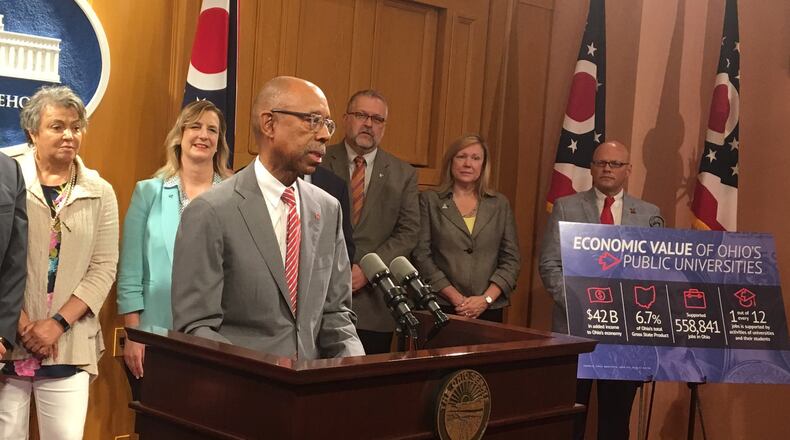Ohio’s per-student spending is currently $1,581 behind the national average of states, Bruce Johnson, president of the Inter-University Council of Ohio, said during a Tuesday presentation at the Statehouse for the campaign.
That marks a slight improvement from 2015, the most recent year for which complete data is available. In 2015, Ohio’s per student spending was $5,078, just over $1,900 shy of the national average of $6,996 at the time.
» RELATED: Wright State may fire suspended provost despite recommendation, attorney says
“We think additional investment is a follow-on conclusion by the members of the general assembly. We always encourage that because it pays off for the taxpayer, it pays off for the student and it pays off for the state government,” Johnson said. “It’s relatively obvious that a state that is $1,581 per-student behind the national average in terms of its support ought to be doing more for its students but obviously we don’t expect them to finish that job in one biennium.”
Historically, students had to pay for about 25 percent of the cost of a college education, Johnson said. But, for the first time in history, students now typically pay more than half the cost of a degree, he said.
When it comes to student financial aid, Ohio spends less than most states. Ohio offers about $120 million in student aid, which is $113.6 million less than the national state average, according to data from The Chronicle of Higher Education.
Ohio university presidents talking about impact on local economy at the Statehouse. pic.twitter.com/eny5mQX3hu
— Max Filby (@MaxFilby) June 12, 2018
The presidents of Wright State University, Central State University, Miami University and several others attended the Tuesday event and a few made their own pitches for why higher education deserves more state money. The less state funding there is, the more difficult it becomes for students to attend college and earn a degree, Wright State president Cheryl Schrader said after the presentation.
“They may not be able to attend college or they may have to do it in a very different way. That makes it difficult for them to focus on their studies,” Schrader said “We have so many students who are working full time and going to school full time. It’s a very different model than what we’ve seen in the past.”
In its latest attempt to push for more state funding, Forward Ohio released a report Tuesday showing that Ohio’s 14 public universities add around $42 billion to the economy. The $42 billion represents 6.7 of Ohio’s “gross state product” according to the report.
» RELATED: Ohio colleges facing new scrutiny for handling of sexual abuse allegations
“This report leaves us with one conclusion and that is higher education is of real value in Ohio,” said state Sen. Randy Gardner, a Bowling Green Republican who serves as senate majority leader and chairman of the senate’s higher education subcommittee.
The report analyzed how many jobs each university supports. In total, Ohio’s universities supported around 558,841 jobs, meaning one in every 12 positions was supported by a public university.
In Wright State’s “Raider Country” region —which includes Montgomery, Clark, Greene, Miami, Preble and 11 other counties —one out of every 57 jobs is supported by the university. Though Wright State laid off 47 employees last year and could lay off up to another 40 this year because of an ongoing budget crisis, the school supports around 20,097 jobs in its 16-county region, according to a portion of the report released by WSU.
By the numbers
$1,581: Amount behind national average Ohio spends per college student.
14: Number of public universities in Ohio.
$42 billion: Estimated economic impact of Ohio's public universities.
1 in 12: Number of jobs supported directly or indirectly by public Ohio universities.
Those statistics alone should encourage the state legislature to invest more in higher education, Schrader said. State appropriations are expected to decline by around $1.4 million at WSU next year, according to the school’s budget.
“State legislators have challenges and decisions to make but I think its important to look at all of the direct benefits,” Schrader said.
Students at Ohio’s public universities get a 13.7 percent return on investment in their education, according to the results of the study. That means for every dollar a student spends on tuition and fees, they’ll make $4.60 back in future earnings.
Over their careers, college graduates tend to make around $1 million more than someone without a degree, said Ohio State University president Michael Drake.
“It makes a real difference,” Drake said. “And, if they go on and get a masters degree or a professional degree or a doctoral degree, that return is dramatically higher.”
FIVE FAST READS
• Algae plaguing Ohio lakes could force Kasich to take executive action
• PHOTOS: Retail tycoon’s former Ohio mansion on sale for $3.95 million
• Ohio colleges taking steps to avoid unchecked sex abuse cases
• The tomato on your Wendy’s burger will be grown in an American greenhouse in 2019
• PHOTOS: Victorian farmhouse with wine cellar, party barn on sale in Troy
The Dayton Daily News is committed to bringing you independent, in-depth stories. Help support our journalism by signing up for a print or digital subscription.
About the Author
